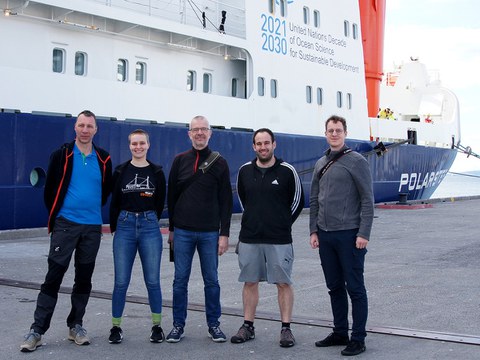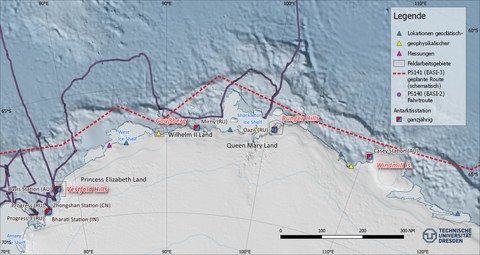Feb 06, 2024
En route to Antarctica on board the Polarstern: TUD geoscientists research in the frozen South

The TUD expedition team before the departure of the Polarstern in Hobart, Australia: Lutz Eberlein, Marie Weber, Mirko Scheinert, Xabier Blanch Gorriz and Erik Loebel (from left to right)
On February 6, 2024, when the German polar research vessel “Polarstern” sets sail from Hobart, Australia, on research cruise PS141, five researchers from TU Dresden will also be on board: Dr. Mirko Scheinert, Lutz Eberlein, and Erik Loebel from the Chair of Geodetic Earth System Research, Xabier Blanch Gorriz from the Junior Professorship in Geosensor Systems, and student Marie Weber (who is in the 5th semester of her studies in Geodesy and Geoinformation). They will work with colleagues from around the world to make measurements that will help reconstruct the development of East Antarctica's climate and ice sheet.
“We want to gain a better understanding of the mechanisms that influence the ice sheet in its current state and future formation, and that can lead to potential instabilities,” explains Dr. Mirko Scheinert. “The interactions of the ice sheet with the Southern Ocean, the solid earth, and the atmosphere are especially crucial here.” The research is part of the multidisciplinary large-scale project, “East Antarctic Ice Sheet Instabilities” (EASI). TU Dresden is part of the responsible consortium consisting of universities, Helmholtz Centers, and partners from Australia and the Netherlands.
The upcoming expedition is the consortium's third research expedition with the “Polarstern” since 2022. The TU Dresden research group, led by Dr. Mirko Scheinert, is currently supported by two Australian scientists and will focus primarily on geodetic-geophysical measurements in East Antarctica’s outer area. Using measurements from global navigation satellite systems (GNSS), the team aims to record the movement of the Earth's crust with the utmost precision, revealing its reaction to past and present changes in ice mass. Together with geophysical measurements, the data should contribute to a better understanding of the deformation and internal structure of the Earth in the East Antarctic region.
A special challenge awaits the researchers on Gaussberg, where they are planning a field camp on land for several weeks. Gaussberg is an extinct volcano that erupted under the Antarctic ice around 56,000 years ago. It was discovered in March 1902 during the first German South Polar expedition led by Erich von Drygalski. Following in their footsteps, the scientists want to conduct a new survey of the area today. In addition to modern geodetic methods and drone photogrammetry, they will use geophysical measurements and detailed geological sampling.
The expedition, led by Prof. Sebastian Krastel of Kiel University, will take just under ten weeks. Polarstern's research cruise PS141 is scheduled to end in Walvis Bay (Namibia) on April 14. EASI-2 took place from December 2023 to the end of January 2024 under the direction of GEOMAR, Helmholtz Centre for Ocean Research Kiel, EASI-1 began in early 2022 under the direction of the Alfred Wegener Institute, Helmholtz Centre for Polar and Marine Research (AWI).
More information:
Chair of Geodetic Earth System Research https://tu-dresden.de/bu/umwelt/geo/ipg/gef?set_language=en
Daily updates and reports from the expedition: https://follow-polarstern.awi.de
Contact:
Dr. Mirko Scheinert
Chair of Geodetic Earth System Research
TU Dresden Press Office
Tel.: +49 351 463-32398

